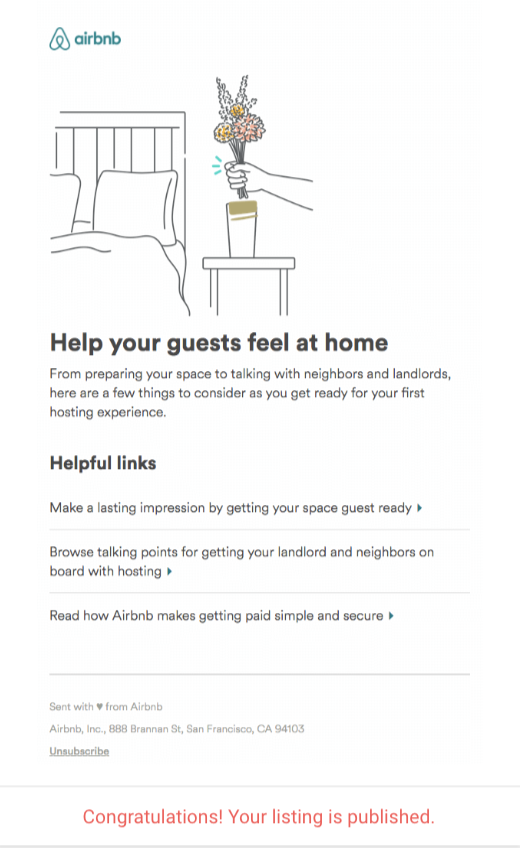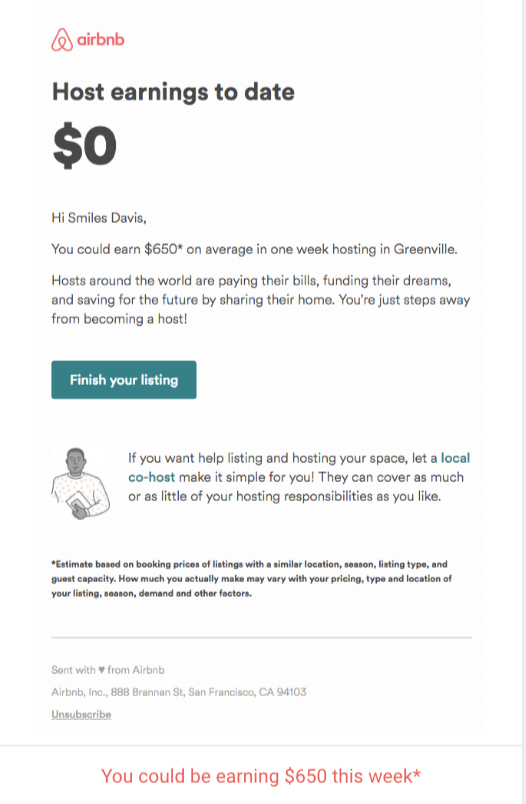When someone first stumbles upon your company, becoming a subscriber or customer for the first time, you want them to have an excellent experience. You want them to understand the value they get from what you offer. That’s why you want to onboard them effectively.
As a travel or hospitality brand, you have an opportunity to provide an excellent onboarding experience using email marketing. With the help of the right email marketing provider, you can guide your subscribers on the path that moves them from subscriber to customer, to loyal customer and brand advocate.
By using basic strategies like email automation, list segmentation, and dynamic content, you can tailor your messages to gain the trust of new subscribers. Today, we’re sharing how you can design an effective onboarding experience for your travel and hospitality customers using savvy email marketing.
Why onboarding matters (and why email is the right solution)
You may be wondering why onboarding matters in the first place. When customers subscribe to your list, your welcome emails act as your first impression. You have a chance to present potential customers with a relevant and warm welcome to your brand at a time when they are interested and listening.
Onboarding with welcome messages also helps you confirm subscriptions and quickly identify what different customers are most interested in with regards to your brand. This helps you accurately build your customer profiles and properly nurture your community of subscribers. In other words, it helps you build sustainable and long-term relationships with your active audience.
Email marketing is the perfect way to onboard customers. Why? Because email marketing has the highest ROI out of any digital marketing strategy. Simply put, when customers subscribe to your email lists, they are showing an active interest in your brand. With the right tools, like a top email marketing provider, you can onboard customers with effective welcome emails and continue to provide value through your messaging.
Mapping the onboarding experience
Before going into more detail about the tools and strategies you can use to create a positive onboarding experience, let’s quickly map the onboarding experience.
Of course, the messages you craft will vary depending on your brand, your customer profiles, and the story you want to tell to your new subscribers—but here is an example of an onboarding welcome series from a top brand, Airbnb, to give you an idea of how onboarding works.
Day 1 – Send subscribers a welcome email with a specific call to action. Airbnb sends a series of welcome emails to subscribers that want to become a host, prompting them to “finish their listing.”
Day 2 – Send your second welcome email with another clear call to action. Airbnb includes a quick list of things the customer has done to complete their profile, and what they still need to do. They also provide a link to the profile to help the subscriber quickly complete the task.
Day 3 – Send another reminder to prompt the subscriber to get on the ball. Airbnb sends an email encouraging subscribers that have completed their profile to “publish” their profile.
Day 4 – If they have completed the action, send another email with the next step. Airbnb does this by providing tips to help hosts get ready for the booking.
Day 5 – Once the welcome actions are completed, you can continue to use automation to set customers on a path to receive more onboarding messages to help customers move forward. Airbnb does this by providing emails that detail how hosts can prepare for guests, make more money, participate more fully in the hosting program, and more.
Again, the onboarding messages that you send will vary depending on the products and services you offer. What is important is that you identify who your customers are, automate welcome messages based on completed actions, and guide subscribers through a path that helps lead them from subscriber to active customer.
Now let’s talk about tools within your email service provider you can use to help you set up a killer onboarding experience.
Providing onboarding via email automation
As a travel and tourism brand, you have different subsets of customers, and you can use automation to set up a basic nurture sequence and give customers a relevant onboarding experience.
Automation pays off. Studies show that automated emails get 86% higher open rates, produce a 196% increase in click-through rates, and generate 320% more revenue than standard promotional emails.
When you set up an automated customer journey, your email service provider will recognize customer actions based on certain triggers and then automatically send a relevant message to the subscriber. Let’s walk through how this might work for a travel and tourism brand that is onboarding a new subscriber.
The most common example of an automated message is a welcome message. When someone subscribes to your list, that can act as a trigger to send an automated welcome message. The welcome message could include basic information about your brand, a promotional offer, or instructions on how to get started with a membership.
This welcome email from travel brand, HipCamp, is an excellent example.
When someone subscribes to HipCamp, that action acts as a trigger and automatically sends a message inviting subscribers to start using their service in unique ways. They can learn more about “hosting,” “camping,” and/or becoming a “field scout.”
Now, here is where automation gets really cool. You’ll notice that within the very first welcome email, there are three different types of potential groups. People that want to camp, people that want to host, and people interested in becoming a field scout.
With the power of automation, HipCamp, could further automate this message by using those links as another trigger. Those who click on “hosting“ could be sent on a customer journey to receive more information about “hosting.” Those subscribers that click on “camping” could be set on an entirely different customer journey geared toward campers. Finally, HipCamp could set up “field scout” as another trigger sending those customers on a customer journey that caters to those interested in becoming a field scout.
There are several other ways you can use triggers and automation to guide a customer journey. You just have to define your goals, collect the right data, define your triggers and rules, define your content and offers, and then set it up in your Campaign Monitor account. Leveraging marketing automation technology to send customer journeys is the perfect way to grow your business.
Using list segmentation for better onboarding
Another awesome way to design a top-notch onboarding experience is through list segmentation.
When you segment your subscriber lists, you are dividing your lists up based on different customer profiles. There are several ways to segment lists and how you segment your lists depends on what type of brand you are, who your target markets are, and how you use data to relevant messages to different people.
For example, a common way to segment lists for travel and tourism brands is based on location. If you are an airline, you don’t want to send all of your deals to every customer. That wouldn’t make sense and would get overwhelming. Instead, you want to send the most relevant deals to subscribers in different areas.
Flight Centre uses this strategy to segment their lists. ClubRed is their email membership program, and they send out exclusive vacation packages, contests, giveaways, and general travel promotions. However, they segment their lists based on location.
They segmented emails across Canada based on eight departure gateways, and major cities in Canada where people would travel from. Additionally, the call out specific promotions such as Toronto to New York, or Toronto to Cuba, in these emails.
This way, people in the varying provinces of Canada receive information about deals and promotions from the location closest to where they live, not all over Canada.
But location is not the only way you can segment your lists. With segmentation, you can even segment your segments. In other words, you could create a segment of “cruise enthusiasts” within your various location segments. And, that’s exactly what Flight Centre does. They send special promotions about cruises to customers who have proven to be interested in information about cruises.
Besides being a great example of segmentation, Flight Centre is also a great example of getting results. They measured their results from employing smart email marketing tactics like segmentation and automation and found an increase in click-through rates of 57%.
Using dynamic content to personalize the experience
Dynamic content is another fun feature of top email service providers that helps you create more personalized messages.
Dynamic content is the ability to switch out bits of content that match different subscriber groups more accurately.
For example, WestJet offers similar travel deals to people in certain locations, but they switch out the images based on their four different demographics: single independent traveler, family traveler, double-income-no-kids type of traveler, and retired traveler.
If you don’t already have this data, you can collect it by launching a creative campaign just like WestJet did. WestJet created a quick quiz asking subscribers to self-identify what type of traveler they are. Then, they used the results to personalize future messages.
This is the perfect way to make your content more relevant to different groups of travelers and tourists. This way, a retired couple gets emails with pictures of retired people enjoying a cruise or vacation while small families get updates about family vacations with pictures to match, and so on.
Switching out images to match customer profiles isn’t the only way to customize messages. You can dynamically switch out the from name, sections of content, videos, products you feature, segments based on consumer engagement, and more.
Wrap up
As a travel and tourism brand, you have an awesome opportunity to connect with your customers in unique ways through email marketing. With the help of email automation, list segmentation, and dynamic content, you can craft messages that resonate well with each and every one of your subscribers on an individual level.
If you’re still using mass email blasts and generic newsletters, the time is now to invest in an email service provider that provides the tools to help you engage with customers from the first day they subscribe, through the onboarding process, and nurture them through the customer lifecycle.
Read more: You Won’t Believe How One Travel Brand Became More Innovative









